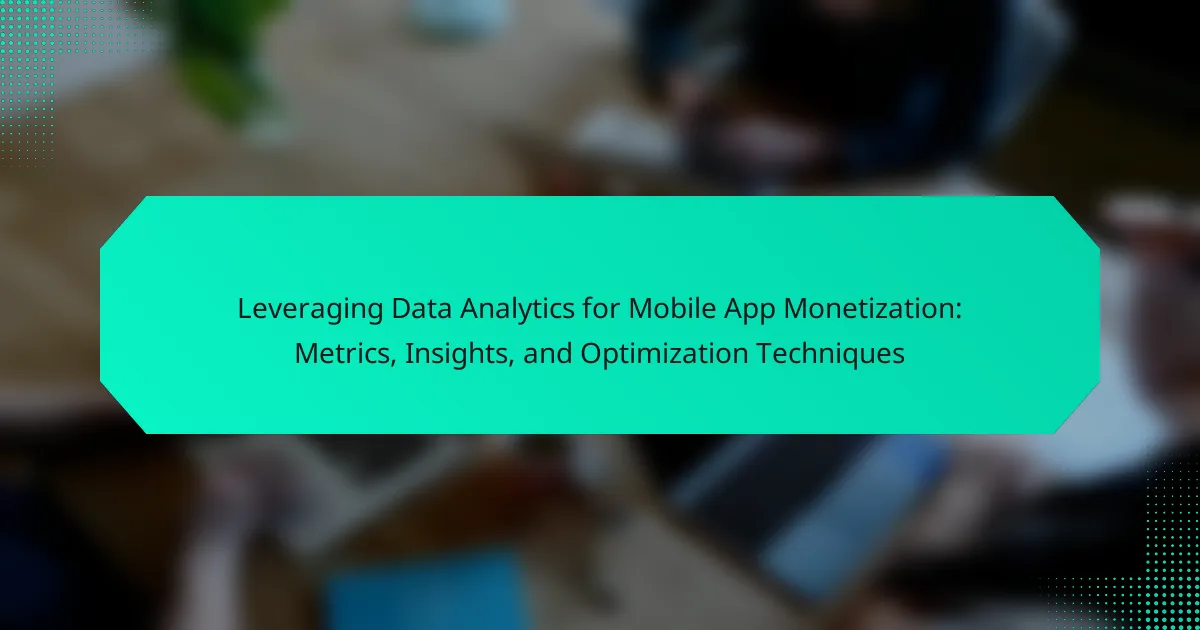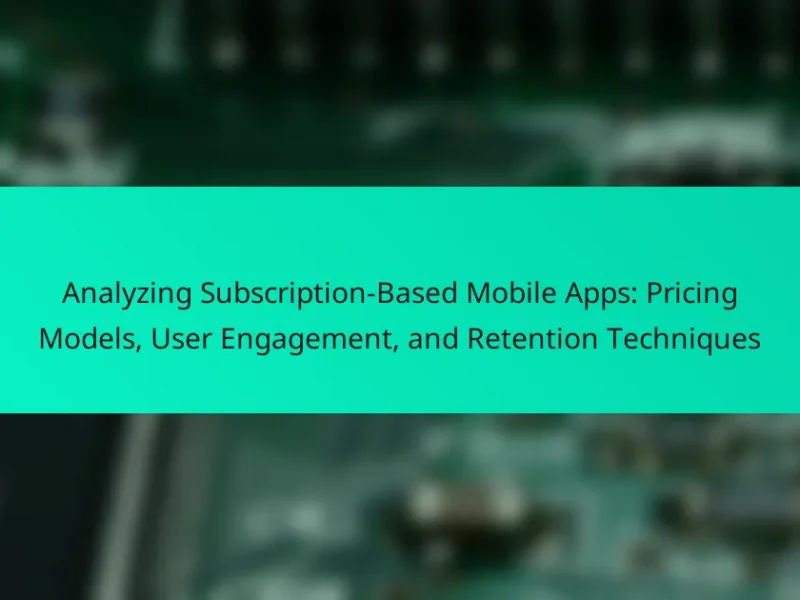Data analytics in mobile app monetization involves the systematic collection and analysis of data to improve revenue generation from mobile applications. Key metrics such as Average Revenue Per User (ARPU), Customer Lifetime Value (CLV), and conversion rates play a crucial role in understanding user behavior and optimizing monetization strategies. Techniques like A/B testing, user segmentation, and tailored in-app purchase strategies are essential for enhancing user engagement and maximizing revenue. This article provides insights into how developers can leverage data analytics to identify trends, improve user retention, and effectively implement monetization techniques for mobile apps.

What is Data Analytics in Mobile App Monetization?
Data analytics in mobile app monetization refers to the process of collecting and analyzing data to enhance revenue generation from mobile applications. This involves tracking user behavior, engagement metrics, and monetization strategies. By analyzing this data, developers can identify trends and optimize their app features. Specific metrics such as user retention rates and in-app purchase behavior are critical. According to a study by App Annie, apps that utilize data analytics can increase their revenue by up to 25%. This demonstrates the effectiveness of data-driven decision-making in maximizing monetization efforts.
How does data analytics influence mobile app monetization strategies?
Data analytics significantly influences mobile app monetization strategies by providing insights into user behavior and preferences. It enables developers to identify which features are most popular among users. This information helps in tailoring in-app purchases and advertisements to match user interests. Furthermore, analytics can reveal the most effective pricing strategies based on user engagement data. For instance, A/B testing can determine the optimal price point for subscriptions. According to a study by App Annie, apps utilizing data analytics for monetization saw a 30% increase in revenue. This demonstrates the concrete financial benefits of leveraging analytics in monetization strategies.
What key metrics are used in data analytics for mobile app monetization?
Key metrics used in data analytics for mobile app monetization include Average Revenue Per User (ARPU), Customer Acquisition Cost (CAC), and Lifetime Value (LTV). ARPU measures the revenue generated per user over a specific period. CAC assesses the cost incurred to acquire a new user. LTV estimates the total revenue a user will generate throughout their engagement with the app. Other important metrics are Daily Active Users (DAU) and Monthly Active Users (MAU), which indicate user engagement levels. Retention rate tracks the percentage of users who continue using the app over time. Churn rate measures the percentage of users who stop using the app. These metrics collectively provide insights into the app’s financial performance and user behavior, guiding monetization strategies.
How can data analytics identify user behavior patterns?
Data analytics can identify user behavior patterns through the analysis of user data and interactions. By collecting data from user activities, analytics tools can track metrics such as session duration, frequency of app usage, and feature engagement. These metrics help in segmenting users based on their behavior. For instance, clustering algorithms can group similar user behaviors, revealing distinct patterns. Additionally, heatmaps can visualize user interactions within the app, highlighting areas of interest. Predictive analytics can forecast future user actions based on historical behavior. According to a study by McKinsey, businesses that leverage user behavior analytics can improve their customer engagement by 20%. This demonstrates the effectiveness of data analytics in understanding user behavior patterns.
What are the primary benefits of leveraging data analytics for monetization?
Leveraging data analytics for monetization provides enhanced decision-making capabilities. Businesses can identify user behavior patterns through analytics. This insight allows for targeted marketing strategies. Improved targeting can lead to higher conversion rates. Data analytics also helps in optimizing pricing models. By analyzing market trends, businesses can adjust prices for maximum revenue. Additionally, analytics facilitates the identification of high-value customer segments. Focusing on these segments can increase profitability. According to a McKinsey report, companies using data-driven strategies are 23 times more likely to acquire customers. These benefits collectively drive revenue growth and improve overall business performance.
How does data analytics enhance user engagement and retention?
Data analytics enhances user engagement and retention by providing insights into user behavior and preferences. It allows developers to track user interactions within the app. This tracking helps identify which features are most popular and which are underused. By analyzing this data, developers can make informed decisions to improve app functionality. Personalization is another key aspect; data analytics enables tailored content and recommendations. This personalization increases user satisfaction and encourages longer sessions. According to a study by App Annie, apps that utilize analytics effectively can see a 20% increase in user retention. Ultimately, data analytics drives continuous improvement, fostering a loyal user base.
What financial advantages can be gained from effective data analytics?
Effective data analytics can lead to significant financial advantages for businesses. It enables informed decision-making, which can optimize resource allocation and reduce costs. For instance, companies that utilize data-driven strategies can improve operational efficiency, resulting in an average cost reduction of 10-25%.
Moreover, effective data analytics enhances customer insights, allowing businesses to tailor their offerings. This personalized approach can increase customer retention rates by up to 30%. Additionally, data analytics can identify profitable market segments, leading to targeted marketing strategies that can boost revenue by 5-10%.
Furthermore, organizations leveraging data analytics often experience faster time-to-market for new products. This agility can provide a competitive edge, increasing market share and overall profitability. According to a McKinsey report, companies that adopt data analytics can see a 20-30% increase in their operating margins.

What metrics should be analyzed for effective mobile app monetization?
Key metrics for effective mobile app monetization include Average Revenue Per User (ARPU), Customer Lifetime Value (CLV), and conversion rates. ARPU measures the revenue generated per user over a specific period. It helps identify the app’s financial health and user engagement levels. CLV estimates the total revenue a business can expect from a single customer throughout their relationship. This metric informs user acquisition strategies and marketing budgets. Conversion rates track the percentage of users who complete desired actions, such as making in-app purchases. High conversion rates indicate effective monetization strategies. Additionally, churn rate measures the percentage of users who stop using the app over time. Lower churn rates suggest better user retention and satisfaction. Analyzing these metrics enables developers to optimize monetization strategies effectively.
Which performance metrics are crucial for understanding app profitability?
Key performance metrics for understanding app profitability include Customer Acquisition Cost (CAC), Lifetime Value (LTV), Average Revenue Per User (ARPU), and Churn Rate. CAC measures the cost to acquire a new user. LTV estimates the total revenue generated from a user over their lifetime. ARPU calculates the average revenue earned per user within a specific time frame. Churn Rate indicates the percentage of users who stop using the app over a period. These metrics provide insights into user behavior and financial performance. For instance, a lower CAC combined with a high LTV indicates a profitable app model.
How do conversion rates impact mobile app monetization?
Conversion rates directly influence mobile app monetization by determining the percentage of users who take desired actions, such as making purchases or subscribing. Higher conversion rates lead to increased revenue, as more users are engaging with monetization features. For example, a 1% increase in conversion rates can significantly boost overall earnings. According to a study by Statista, mobile app revenue is projected to reach $407 billion by 2026, emphasizing the importance of optimizing conversion rates. Effective strategies, such as A/B testing and user experience enhancements, can improve these rates and, consequently, monetization outcomes.
What role does customer lifetime value play in monetization strategies?
Customer lifetime value (CLV) is a critical metric in monetization strategies. It quantifies the total revenue a business can expect from a customer over their entire relationship. Understanding CLV helps businesses allocate resources effectively. Companies can invest more in customer acquisition when they know the potential return. Additionally, CLV informs pricing strategies and product offerings. Businesses can tailor their services based on customer segments with high CLV. According to a study by McKinsey, increasing customer retention rates by 5% can increase profits by 25% to 95%. This illustrates the importance of focusing on high-CLV customers for sustained revenue growth.
What insights can be derived from user data analytics?
User data analytics provides insights into user behavior, preferences, and engagement patterns. These insights can help identify trends in app usage. For example, analytics can reveal peak usage times, guiding optimal push notification schedules. User segmentation analysis can categorize users based on behavior, allowing for targeted marketing strategies. Additionally, retention rates can be assessed to understand user loyalty. By analyzing user feedback and ratings, developers can identify areas for improvement. Metrics such as average session duration can indicate user engagement levels. Overall, these insights enable data-driven decisions to enhance user experience and drive monetization strategies.
How can user demographics inform monetization decisions?
User demographics can significantly inform monetization decisions by revealing insights into user preferences and behaviors. Understanding age, gender, income, and location helps tailor monetization strategies. For instance, younger users may prefer in-app purchases, while older demographics might favor subscription models.
Data from Statista indicates that 66% of mobile gamers aged 18-34 spend money on in-app purchases. This statistic highlights the importance of targeting monetization strategies to specific age groups. Additionally, income levels can dictate spending capacity, influencing pricing strategies for premium features.
Location data can also inform regional pricing adjustments. In countries with lower average incomes, lower pricing may increase user acquisition. Overall, analyzing user demographics allows for more effective targeting, leading to improved conversion rates and revenue generation.
What trends in user behavior should be monitored for optimization?
User behavior trends that should be monitored for optimization include engagement rates, retention rates, and conversion rates. Engagement rates indicate how frequently users interact with the app. High engagement suggests that users find value in the app’s features. Retention rates measure how many users return after their first use. A high retention rate indicates user satisfaction and effective onboarding processes. Conversion rates track how many users complete desired actions, such as making purchases. Increasing conversion rates can significantly enhance monetization. Additionally, monitoring session duration and frequency can provide insights into user habits. Analyzing these trends helps identify areas for improvement and informs targeted optimization strategies.

What optimization techniques can enhance mobile app monetization?
Optimization techniques that can enhance mobile app monetization include A/B testing, user segmentation, and in-app purchase strategies. A/B testing allows developers to compare different versions of app features to determine which generates higher revenue. User segmentation helps identify distinct user groups, enabling personalized marketing strategies that increase engagement and spending. In-app purchase strategies, such as offering limited-time discounts or exclusive content, can drive sales. Additionally, optimizing ad placements and formats can improve ad revenue. According to a 2022 report by App Annie, apps that utilized A/B testing saw a 20% increase in conversion rates.
How can A/B testing be utilized to improve monetization strategies?
A/B testing can enhance monetization strategies by allowing businesses to compare different versions of their offerings. This method involves presenting two variations to users and measuring their responses. For instance, a mobile app might test two different pricing strategies. By analyzing which version yields higher revenue, companies can make informed decisions.
Statistical significance is crucial in A/B testing. It ensures that the results are reliable and not due to random chance. According to a study by Optimizely, businesses that consistently use A/B testing can see conversion rate improvements of 20% or more.
Additionally, A/B testing can optimize user experience. By testing variations in features or layouts, businesses can identify what engages users most effectively. This leads to increased retention and, ultimately, higher monetization.
In summary, A/B testing provides concrete data that informs monetization strategies through direct user feedback and measurable outcomes.
What factors should be tested during A/B testing for maximum impact?
Factors that should be tested during A/B testing for maximum impact include headlines, call-to-action buttons, and images. Testing different headlines can reveal which wording resonates better with users. Call-to-action button variations help identify which design prompts more clicks. Image changes can affect user engagement and conversion rates. Additionally, testing layout designs can optimize user experience. Content length variations can influence how well users absorb information. Timing of notifications or offers can also impact user response rates. Lastly, testing pricing strategies can determine the most effective price points for conversions. Each of these factors has shown to significantly affect user behavior and overall app performance.
How do user feedback and analytics inform optimization efforts?
User feedback and analytics directly inform optimization efforts by providing actionable insights. User feedback highlights areas where users experience difficulties. Analytics reveal patterns in user behavior and engagement metrics. Together, they identify features that need improvement or enhancement. For example, a study by Nielsen Norman Group found that 70% of app users abandon an app due to poor usability. This emphasizes the importance of addressing user concerns. Additionally, analytics can track the effectiveness of changes made based on feedback. This iterative process ensures that optimization efforts are data-driven and user-centric. Ultimately, leveraging both user feedback and analytics leads to improved user satisfaction and retention.
What are some best practices for leveraging data analytics in mobile app monetization?
Utilize data analytics to enhance mobile app monetization through targeted insights. First, identify key performance indicators (KPIs) such as user engagement and conversion rates. Analyze user behavior to understand preferences and optimize the user experience. Implement A/B testing to evaluate different monetization strategies, such as in-app purchases or ads. Segment users based on demographics and behaviors to tailor marketing efforts effectively. Leverage cohort analysis to track user retention and lifetime value over time. Use predictive analytics to forecast trends and adjust strategies proactively. Data-driven decisions can lead to increased revenue and improved user satisfaction.
How can app developers ensure data accuracy and relevance?
App developers can ensure data accuracy and relevance by implementing robust validation techniques. They should utilize automated data validation tools to check for inconsistencies. Regularly updating data sources is essential to maintain relevance. Conducting user feedback surveys helps identify data gaps. Employing analytics tools can provide insights into data trends. Cross-referencing data with reliable external sources enhances accuracy. Continuous monitoring of data quality metrics is necessary for ongoing improvements. These practices are supported by research indicating that accurate data leads to better decision-making in app development.
What tools are recommended for effective data analytics in mobile apps?
Google Analytics for Firebase is a recommended tool for effective data analytics in mobile apps. It provides insights into user behavior and engagement. Mixpanel is another powerful tool that offers advanced analytics features, including cohort analysis. Amplitude focuses on user retention and conversion metrics, making it ideal for monetization strategies. Flurry Analytics delivers comprehensive app usage data and audience segmentation. Adjust combines app analytics with marketing attribution, helping to track campaign performance. These tools are widely used in the industry and are known for their effectiveness in driving data-driven decisions.
The main entity of the article is data analytics in mobile app monetization. The article provides a comprehensive overview of how data analytics enhances revenue generation through user behavior analysis, engagement metrics, and monetization strategies. Key topics include essential metrics for evaluating app performance, the influence of user demographics, and optimization techniques like A/B testing. Additionally, it highlights the financial advantages of leveraging analytics and the importance of user feedback in driving continuous improvement. The content aims to equip developers with insights and strategies for maximizing app monetization through effective data utilization.


